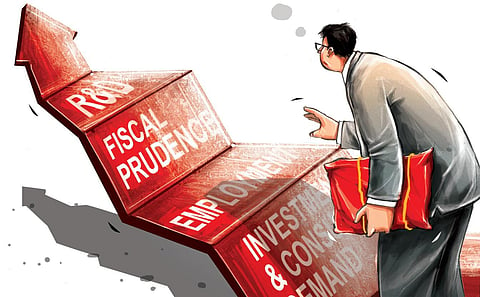

The Union Budget 2023–24 is going to be presented in times of predictable unpredictability and certain uncertainty, which have invariably become the “new normal”. We are facing a protracted war in Ukraine, resurgence of Covid-19, economic slowdown with rising inflation and tight government budgets, extreme weather events and rapid social and technological change.
Economically, India today is more integrated with the world than ever before. Shocks emanating outside its political frontiers have considerable impact on it. While the economy has shown resilience and has been a bright spot amidst a bleak global growth outlook, it continues to face risks from geopolitical spillovers and geoeconomic flux. Private investment recovery is delayed as investors are waiting for external contingencies to stabilise and domestic demand to pick up. Exporters are staring at subdued demand with the global economic slowdown. Households are yet to fully emerge from the ravages of Covid-19—and with rising inflation—are facing shrinking balance sheets.
Hence, at this critical juncture of India’s development journey, the finance minister is faced with the “trilemma” of providing impetus to investment and growth, while containing inflation and keeping the fiscal deficit in check. Equally important will be to address the sustainability and technology imperatives and retain the focus on the prime minister’s call for ‘Sabka Saath, Sabka Vikas, Sabka Vishwas’ (Together, for everyone’s growth, with everyone’s trust).
The first suggestion for the forthcoming budget is to support demand, both investment and consumption demand. With regards to investment demand, despite the limited fiscal space, government support for capex-led growth should continue, especially in infrastructure. The budget should increase allocation to capital expenditure by 35% like last year, taking the total public capex to about ₹10 lakh crore. Public investment in infrastructure would have a high spillover impact on the economy and would crowd-in private investment.
Apart from investment demand, reviving consumer demand is equally important for supporting growth. As we witness times of high inflation and slowing disposable incomes, it is important that income tax slabs and rates for individuals be rationalised. A reduced effective tax rate at the lower end will put more money in the hands of consumers and increase consumption, creating room for investments and jobs.
Second, while we focus on rejuvenating consumption and investment demand, care must be taken to maintain fiscal prudence. The Centre should adhere to the fiscal deficit target of 6.4% of GDP for this fiscal and continue the process of gradual reduction in the deficit in the next fiscal which should culminate in the deficit moving towards the goalpost of 4.5% by FY26.
The third suggestion is to revive growth by promoting and further boosting world-class manufacturing in India. It requires a focus on not only improving the Ease of Doing Business, but also on reducing the Cost of Doing Business. Much progress has been made on Ease of Doing Business, but there is more work to be done. It could be significantly improved through greater digitisation of regulatory and compliance frameworks, faster and time-bound clearances, contract enforcement, and a genuine single-window system encompassing Central and state clearances. Further, all business-related laws including Partnership Act, IBC, GST Act, etc., should be decriminalized. No arrests or detention should take place in civil cases unless criminalisation in business has been proved beyond doubt.
We are witnessing a new paradigm of co-existence of cooperative and competitive federalism in India. Given the success of the GST Council, the Centre could look at forming similar councils for reforms in areas such as land, labour, power, and agriculture, where consensus building is difficult and adds to the Cost of Doing Business.
The budget should complement these through tax reforms. Apart from the rationalisation of income tax rates, extension of the sunset date of 15% concessional tax rate for new manufacturing units by a year to March 2025 will be helpful. Further, the indirect tax regime should see a shift towards a three-tier structure with the exception of a few products presently in the higher slabs. Duties on imports of inputs or raw materials should be in the lowest or nil slab, intermediates in the lower slab (2.5–5%) and final products in the standard slab.
Fourth, as India looks to harness its demographic dividend, focus on employment generation will be critical. This can be facilitated by promoting more labour-intensive industries such as furniture, leather, toys, etc., through the PLI scheme; encouraging labour-intensive services such as tourism, logistics and hospitality through an Employment Linked Incentive (ELI) scheme, pushing growth in infrastructure and construction sectors; promoting schemes such as ODOP at the district level, raising outlays on MNREGA, etc.
The fifth area is sustainability. India is one of the very few countries globally to have walked the talk on climate commitments and has set an ambitious goal of achieving Net Zero by 2070. To move forward on this commitment, the budget could announce a specialised Development Finance Institution (DFI) to fund the energy transition and other climate change mitigation and adaptation measures. Announcing a PLI for electrolysers and including green ammonia/green hydrogen in the harmonised list of infrastructure sub-sectors will be in line with the Centre’s goal to promote India as a hub for green hydrogen.
Finally, as economic activity increasingly becomes innovation and technology-driven, R&D will be a key enabler for growth and competitiveness. Increasing investment in R&D from the present level of 0.7% to 2.5% by 2030 and 4% by 2047 is most important. The budget could set up a joint Industry-Government Science and Technology Advisory Council to deliberate on the key enablers for achieving this goal.
Despite the global headwinds, the economy has shown resilience and going forward, can be an engine of global growth. The upcoming budget presents the perfect opportunity to transform India.
Chandrajit Banerjee
Director General, Confederation of Indian Industry